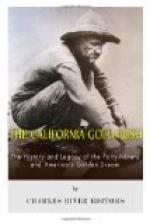Altogether the visitors must have been greatly impressed, not only with the strength of the organization, but also with the care used in preparing it for every emergency, the perfection of its discipline, and the completeness of its equipment. When the Committee of Vigilance of 1856 adjourned subject to further call, there must have been in most men’s minds the feeling that such a call could not again arise for years to come.
Yet it was not so much the punishment meted out to evil-doers that measures the success of the Vigilante movement. Only four villains were hanged; not more than thirty were banished. But the effect was the same as though four hundred had been executed. It is significant that not less than eight hundred went into voluntary exile.
“What has become of your Vigilance Committee?” asked a stranger naively, some years later.
“Toll the bell, sir, and you’ll see,” was the reply[8].
[8: Bancroft, Popular Tribunals, 11, 695.]
BIBLIOGRAPHICAL NOTE
California has been fortunate in her historians. Every student of the history of the Pacific coast is indebted to the monumental work of Hubert H. Bancroft. Three titles concern the period of the Forty-niners: The History of California, 7 vols. (1884-1890); California Inter Pocula, 1848-56 (1888); Popular Tribunals, 2 vols. (1887). Second only to these volumes in general scope and superior in some respects is T.H. Hittell’s History of California, 4 vols. (1885-1897). Two other general histories of smaller compass and covering limited periods are I.B. Richman’s California under Spain and Mexico, 1535-1847 (1911), and Josiah Royce’s California, 1846-1856 (1886). The former is a scholarly but rather arid book; the latter is an essay in interpretation rather than a narrative of events. One of the chief sources of information about San Francisco in the days of the gold fever is The Annals of San Francisco (1855) by Soule and others.




